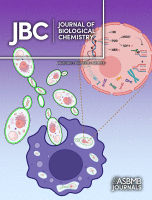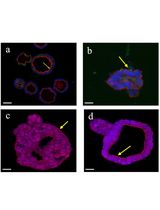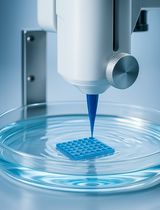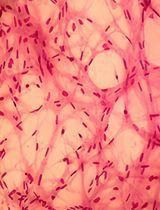- EN - English
- CN - 中文
Culture and Characterization of Differentiated Airway Organoids from Fetal Mouse Lung Proximal Progenitors
来源于胎鼠肺近端前体细胞的分化气道类器官的培养与表征
(*contributed equally to this work) 发布: 2024年12月05日第14卷第23期 DOI: 10.21769/BioProtoc.5129 浏览次数: 1689
评审: Valeria Fernandez ValloneSamantha HallerAnonymous reviewer(s)
Abstract
Developing a physiologically relevant in vitro model of the respiratory epithelium is critical for understanding lung development and respiratory diseases. Here, we describe a detailed protocol in which the fetal mouse proximal epithelial progenitors were differentiated into 3D airway organoids, which contain terminal-differentiated ciliated cells and basal stem cells. These differentiated airway organoids could constitute an excellent experimental model to elucidate the molecular mechanisms of airway development and epithelial cell fate determination and offer an important tool for establishing pulmonary dysplasia disease in vitro.
Key features
• Efficient isolation of proximal epithelial progenitors from mouse embryos.
• Differentiation of pulmonary airway organoids differentiated from tracheal progenitors, which recapitulates the process of airway cell differentiation.
• Airway organoids can be used to explore the molecular mechanisms of lung development and respiratory diseases.
Keywords: Airway organoids (气道类器官)Graphical overview
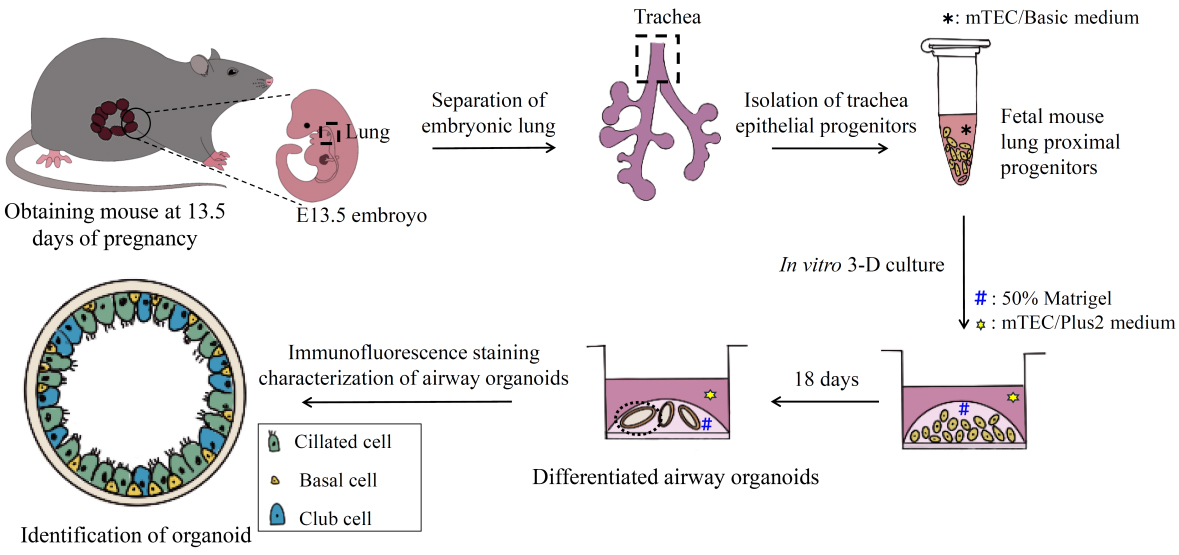
Overview of the culture of airway organoids from isolated E13.5 mouse proximal epithelial cells
Background
The pseudostratified airway epithelium is the first mechanical barrier of the respiratory system and maintains tissue homeostasis after injury. The airway epithelium consists of secretory club cells, terminally differentiated ciliated cells, basal stem cells, and a small population of goblet cells, neuroendocrine cells, and ionocytes [1]. All types of proximal airway epithelial cells differentiate from Sox2+ progenitors during embryonic lung development [2]. Deficiencies in early embryonic development of the airway epithelium are frequently associated with neonatal mortality, as well as a variety of life-threatening lung diseases in adulthood, including bronchopulmonary dysplasia, chronic obstructive pulmonary disease, and lung cancer.
Recent advances in in vitro 3D culture techniques enable the generation of organoids derived from stem or progenitor cells, which functionally and morphologically mimic the airway epithelium at a near-physiological level [3,4]. This approach has allowed researchers to elucidate the molecular mechanisms of lung development and the consequences of genetic alterations associated with various respiratory diseases [5,6]. Additionally, several research groups have developed lung organoid disease models for preclinical drug screening [7–10].
We previously reported a tracheal progenitor isolation and culture system that can generate airway organoids containing differentiated epithelial cells [11]. Here, we provide a detailed protocol to generate 3D airway organoids with hollow structures derived from isolated proximal epithelial progenitors of E13.5 mouse tracheas, the same source for generating airway organoids as previously reported [11]. Compared with the trans-well air-liquid interface (ALI) culture, this protocol requires fewer progenitors and the resulting 3D organoids are more suitable for in vivo transplantation for the study of diseases [12,13]. This robust in vitro 3D culture model provides an opportunity to explore the molecular mechanisms of early lung development and relevant respiratory diseases in an experimentally tractable system.
Materials and reagents
Biological materials
10–12-week-old adult male mice and sexually attracted female mice; obtained from the Animal Experimental Center of Anhui Medical University
Reagents
PBS (Thermo Fisher, catalog number: 20012027), store at RT
Ethanol absolute (Hushi, catalog number: 10009218), store at RT
Sucrose (Sigma-Aldrich, catalog number: V900116), store at RT
Triton X-100 (Sigma-Aldrich, catalog number: T8787), store at RT
Normal goat serum (Gibco, catalog number: 16210-064), shelf-life is 3 months, store at -20 °C
NaN3 (Sigma-Aldrich, catalog number: S2002), dissolve 2 g in 1 mL of sterile Milli-Q-treated water, store at -20 °C.
Caution: NaN3 is hazardous. Avoid inhalation, ingestion, and skin contact.
Tween-20 (Sigma-Aldrich, catalog number: P1379), add 10 µL of Tween-20 in PBS to 10 mL, store at RT
Optimal cutting temperature compound (OCT) (Sakura, catalog number: 4853), store at RT
Chloral hydrate (MACKLIN, catalog number: 302-17-0), dissolve 10 g in 90 mL of sterile Milli-Q-treated water, store at 2–8 °C
Matrigel basement membrane matrix, growth factor reduced (GFR) (Corning, catalog number: 354230), store at -80 °C
Note: Thaw Matrigel on an icebox in a 4 °C refrigerator, aliquot in 200 μL vials upon arrival, and minimize freeze and thaw cycles; it will polymerize at temperatures above 10 °C.
Paraformaldehyde (PFA) (MACKLIN, catalog number: 30525-89-4), dissolve 20 g of PFA in 500 mL of sterile PBS to prepare 4% PFA. Shelf-life is 2 months; store at 2–8 °C
Caution: PFA is hazardous. Avoid inhalation, ingestion, and skin contact. Use protective equipment and work in a fume hood.
Type I rat tail collagen (Corning, catalog number: 354236), dissolve 4 mg of Type I rat tail collagen in 1 mL of 0.02 N acetic acid to prepare 4 mg/mL Type I rat tail collagen, then add 50 μL of 4 mg/mL Type I rat tail collagen in 1.95 mL of 0.02 N acetic acid to prepare 0.1 mg/mL Type I rat tail collagen. Store at -20 °C
Acetic acid (Sigma-Aldrich, catalog number: 695092), dissolve 1 mL in 87 mL of sterile Milli-Q-treated water. Use a syringe filter to filter the acetic acid solution; store at -20 °C
Penicillin/streptomycin (PS) (Life Technologies, catalog number: 15140-163), with 10,000 units penicillin and 10 mg streptomycin per milliliter in 0.9% NaCl; store at -20 °C
DMEM (high glucose, L-glutamine, sodium pyruvate, sodium bicarbonate, phenol red, w/o HEPES) (VivaCell, catalog number: 113-0500), store at 2–8 °C
DMSO (Solarbio, catalog number: D8370), store at RT
Advanced DMEM/F-12 (Gibco, catalog number: C11330500BT), store at 2–8 °C
GlutaMAX, 0.4 M (Gibco, catalog number: 35050061), store at 2–8 °C
HEPES, 1 M (Gibco, catalog number: 15630-080), store at 2–8 °C
PrimocinTM, 50 mg/mL (InvivoGen, catalog number: ant-pm), store at -20 °C aliquoted. Avoid multiple freeze-thaw cycles
NaHCO3 (Sigma-Aldrich, catalog number: S6014), dissolve 0.75 g in 10 mL of sterile Milli-Q-treated water. Use a syringe filter to filter the solution; store at -20 °C
FBS (Biowest, catalog number: S1580-500), store at -20 °C
HBSS (Gibco, catalog number: 14175), store at RT
BSA (Sigma-Aldrich, catalog number: V900933), dissolve 0.1 g in 10 mL of PBS to prepare 1% BSA, store at 2–8 °C
EGF (Corning, catalog number: 354001), dissolve 100 μg in 4 mL of HBSS + 0.1% BSA. Shelf-life is 3 months; store at -20 °C aliquoted
CHIR99021 (Tocris, catalog number: 4423), dissolve 1 mg in 716.3 μL of DMSO. Shelf-life is 3 months; store at -20 °C aliquoted
Y-27632 (Tocris, catalog number: 1254), dissolve 1 mg in 624.5 μL of PBS. Shelf-life is 1 year; store at -20 °C aliquoted
Retinoic acid (Sigma-Aldrich, catalog number: R2625), dissolve 1 mg in 13.31 mL of DMSO. Make fresh each time and store at -20 °C
Note: Vortex retinoic acid stock before making the working solution. This is light sensitive; store in the dark.
Transferrin (Sigma-Aldrich, catalog number: T1147-100 mg), dissolve 100 mg in 20 mL of HBSS + 0.1% BSA. Shelf-life is 2 months; store at -20 °C aliquoted
A-8301 (AbMole, catalog number: M5037), dissolve 5 mg in 23.72 mL of DMSO. Shelf-life is 2 months; store at -20 °C aliquoted
Insulin (Sigma-Aldrich, catalog number: I6634), dissolve 100 mg in 50 mL of 4 mM HCl. Shelf-life is 28 days; store at -20 °C aliquoted
Noggin (Sino Biological, catalog number: 10267), dissolve 1 mg in 50 μL of PBS. Shelf-life is 1 year; store at -20 °C aliquoted
Cholera toxin (Sigma-Aldrich, catalog number: 9012-63-9), dissolve 1 mg in 4 mL of HBSS + 0.1% BSA. Shelf-life is 1 year; store at -20 °C aliquoted
Pronase (Sigma-Aldrich, catalog number: 9036-06-0), dissolve 15 mg of Pronase in 10 mL of Ham’s F12
Note: Use a 0.22 µm sterile filter to filter the Pronase solution and make fresh each time.
Ham’s F12 (Corning, catalog number: 10-080-cv), store at 2–8 °C
Anti-fluorescence quenching agent (Beijing Biotopped Technology, catalog number: Top0702). Shelf-life is 1 year; store at 2–8 °C. This is light sensitive; store in the dark
Antibodies
Anti-mouse Tp63 (Santa Cruz Biotechnology, catalog number: sc-25268), we recommend dilution at 1:400 with dilution buffer and storing at -20 °C aliquoted. Fresh dilution is prepared before staining
Anti-mouse acetylated α Tubulin (Abcam, catalog number: ab-24610), we recommend dilution at 1:400 with dilution buffer and storing at -20 °C aliquoted. Fresh dilution is prepared before staining
Anti-rabbit Krt5 (Abcam, catalog number: ab-64081), we recommend dilution at 1:250 with dilution buffer and storing at -20 °C aliquoted. Fresh dilution is prepared before staining
Goat anti-rabbit 555 (Life Technologies, catalog number: A21430), we recommend dilution at 1:1,000 with dilution buffer and storing at -20 °C aliquoted. This is light sensitive; store in the dark. Fresh dilution is prepared before staining
Goat anti-mouse 488 (Life Technologies, catalog number: A11029), we recommend dilution at 1:1,000 with dilution buffer and storing at -20 °C aliquoted. This is light sensitive; store in the dark. Fresh dilution is prepared before staining
DAPI (Sigma-Aldrich, catalog number: D9542), we recommend dilution at 1:1,000 with dilution buffer and storing at -20 °C aliquoted. This is light sensitive; store in the dark. Fresh dilution is prepared before staining
Solutions
Buffer solution (see Recipes)
Suspension medium (see Recipes)
mTEC/basic medium (see Recipes)
mTEC/Plus1 medium (see Recipes)
mTEC/Plus2 medium (see Recipes)
Blocking buffer (see Recipes)
Dilution buffer (see Recipes)
Recipes
Buffer solution (50 mL)
Shelf-life is 1 month; store at 2–8 °C.
Reagent Final concentration Volume PBS n/a 49.5 mL Penicillin/streptomycin 500 U/mL 500 μL Suspension medium (50 mL)
Make fresh each time and store at 2–8 °C.
Reagent Final concentration Volume DMEM n/a 47 mL FBS 5% 2.5 mL Penicillin/streptomycin 500 U/mL 0.5 mL mTEC/basic medium (50 mL)
Shelf-life is 1 month; store at 2–8 °C.
Reagent Stock concentration Final concentration Volume Advanced DMEM/F-12 n/a n/a 48.05 mL HEPES 1 M 15 mM 0.75 mL Penicillin/streptomycin 500 U/mL 500 U/mL 0.5 mL GlutaMAX 0.4 M 4 mM 0.5 mL NaHCO3 0.9 M 3.6 mM 0.2 mL mTEC/Plus1 medium (3 mL)
Shelf-life is 1 month; store at 2–8 °C.
Reagent Stock concentration Final concentration Volume MTEC/basic medium n/a n/a 2.82 mL FBS 100% 5% 150 μL EGF 25 μg/mL 25 ng/mL 3 μL Insulin 2 mg/mL 10 μg/mL 15 μL Transferrin 5 mg/mL 5 μg/mL 3 μL Cholera toxin 250 μg/mL 0.1 μg/mL 1.2 μL PrimocinTM 50 mg/mL 100 μg/mL 6 μL mTEC/Plus2 medium (1 mL)
Make fresh each time and store at 2–8 °C.
Reagent Stock concentration Final concentration Volume MTEC/Plus1 medium n/a n/a 996.4 μL Retinoic acid 250 μM 50 nM 0.2 μL Y-27632 5 mM 5 μM 1 μL CHIR99021 3 mM 3 μM 1 μL A8301 500 μM 500 nM 1 μL Noggin 20 mg/mL 20 μg/mL 1 μL Blocking buffer (10 mL)
Make fresh each time and store at 2–8 °C.
Reagent Stock concentration Final concentration Volume PBS n/a n/a 7.98 mL Normal goat serum 100% 20% 2 mL Triton X-100 100% 0.1% 10 μL NaN3 2 g/mL 0.2 mg/mL 1 μL Tween-20 100% 0.05% 5 μL Dilution buffer (10 mL)
Make fresh each time and store at 2–8 °C.
Reagent Stock concentration Final concentration Volume PBS n/a n/a 9.78 mL Normal goat serum 100% 2% 0.2 mL Triton X-100 100% 0.1% 10 μL NaN3 2 g/mL 0.2 mg/mL 1 μL Tween-20 100% 0.05% 5 μL
Laboratory supplies
1 mL syringe (Jiufekang, catalog number: 045X15RWLB), containing 4.5-gauge syringe needle
24-well plates (Corning, catalog number: 353047)
35 mm culture dish (Sparkjade, catalog number: GF0006)
60 mm culture dish (Sparkjade, catalog number: GF0007)
1.5 mL centrifuge tube (Sparkjade, catalog number: NZ-86009)
Falcon, 50 mL centrifuge tube (Wocas, catalog number: NZ-86011)
Falcon, 15 mL centrifuge tube (Wocas, catalog number: NZ-86010)
Pipette tip, 10, 200, 1,000 µL (Wocas, catalog numbers: NZ-86001, NZ-86002, NZ-86003)
Parafilm M wrapping film (Thermo Fisher, catalog number: 1337416)
300-mesh cell strainers (Sangon biotech, catalog number: F513453)
Adhesion microscope slides (Citotest, catalog number: 80312-3161)
Syringe filter (SHIGOUYI, catalog number: SFMCE013022NA)
Dyeing tank (Biosharp, catalog number: BS-WB-20B)
Equipment
Cell culture hood (Nuaire, model: NU-425-400S)
Cell culture incubator (Nuaire, model: NU-5510E)
Cell counter (Biosharp, model: BS-QT-1103)
Cryostat (Yidi, model: YD-1900), set from 0 to -40 °C
Surgical scissors (Merck, catalog numbers: S3146)
Surgical forceps (Biolab, catalog numbers: Z168777 and Z225614)
Vortex mixer (Kylin-bell, model: VORTEX-5)
Ice machine (PHCbi, model: SIM-F140AY65-PC)
Autoclave (TOMY, model: SX-500)
Brightfield microscope (Leica, model: DMI3000B)
Cell culture benchtop centrifuge (Merck, model: MGL-16MA)
Micropipettes (Dragon, catalog numbers: 7010101004, 7010101005, 7010101006, 7010101009, 7010101016)
Pure water technology (Zhiang, model: Best-R)
37 °C water bath (Changzhou Yuexin, model: HH-1)
Stereomicroscope (Olympus, model: SZX16)
Multiphoton laser scanning microscope (Leica, model: TCS SP8 DVE)
Procedure
文章信息
稿件历史记录
提交日期: Aug 7, 2024
接收日期: Oct 7, 2024
在线发布日期: Oct 22, 2024
出版日期: Dec 5, 2024
版权信息
© 2024 The Author(s); This is an open access article under the CC BY-NC license (https://creativecommons.org/licenses/by-nc/4.0/).
如何引用
Readers should cite both the Bio-protocol article and the original research article where this protocol was used:
- Zhang, Z., Tao, C. and Li, Q. (2024). Culture and Characterization of Differentiated Airway Organoids from Fetal Mouse Lung Proximal Progenitors. Bio-protocol 14(23): e5129. DOI: 10.21769/BioProtoc.5129.
- Li, Q., Jiao, J., Heng, Y., Lu, Q., Zheng, Y., Li, H., Cai, J., Mei, M. and Bao, S. (2023). Prmt5 promotes ciliated cell specification of airway epithelial progenitors via transcriptional inhibition of Tp63. J Biol Chem. 299(8): 104964.
分类
发育生物学 > 细胞生长和命运决定 > 分化
干细胞 > 类器官培养
细胞生物学 > 细胞分离和培养 > 3D细胞培养
您对这篇实验方法有问题吗?
在此处发布您的问题,我们将邀请本文作者来回答。同时,我们会将您的问题发布到Bio-protocol Exchange,以便寻求社区成员的帮助。
Share
Bluesky
X
Copy link


